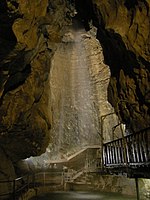Saint-Maurice, Switzerland
Cities in SwitzerlandCultural property of national significance in ValaisMunicipalities of ValaisPopulated places on the RhônePopulated riverside places in Switzerland

Saint-Maurice is a city in the Swiss canton of Valais and the capital of the district of Saint-Maurice. On 1 January 2013, the former municipality of Mex merged into the municipality of Saint-Maurice.Saint-Maurice is the site of the Ancient Roman outpost of Agaunum and the 6th-century Abbey of Saint-Maurice d'Agaune. The city is located at the entrance of a pass leading to the upper part of the Rhône valley. As such, it has a strategic importance, and defence work were built from the 15th century to control this access. The Fortress Saint-Maurice was constructed in the surrounding mountainsides from 1880 through 1995.
Excerpt from the Wikipedia article Saint-Maurice, Switzerland (License: CC BY-SA 3.0, Authors, Images).Saint-Maurice, Switzerland
Sous-le-Scex,
Geographical coordinates (GPS) Address Nearby Places Show on map
Geographical coordinates (GPS)
| Latitude | Longitude |
|---|---|
| N 46.216666666667 ° | E 7 ° |
Address
Sous-le-Scex 5
1890 (Saint-Maurice)
Wallis, Switzerland
Open on Google Maps







